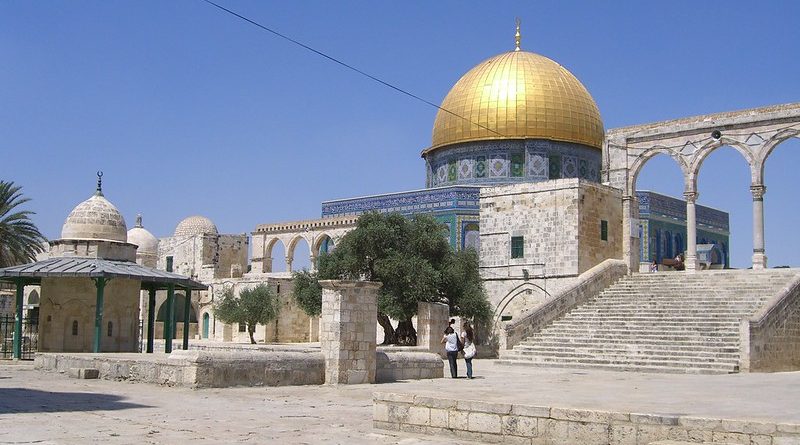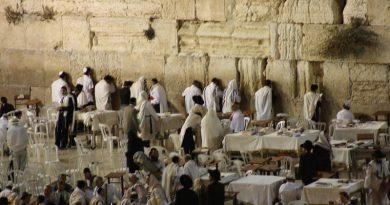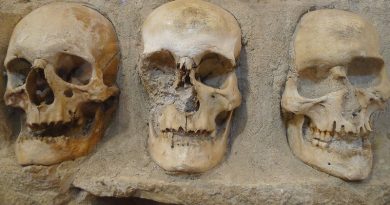Jerusalem’s Ten Most Iconic Sites
One of the oldest and holiest cities in the world, Jerusalem is hugely significant to all three of the Abrahamic religions – Judaism, Christianity and Islam – and this sometimes serves as a source of conflict. Its extensive history and religious significance means that there are no shortage of important sites.
Dome of the Rock
Israel’s most recognisable landmark, the Dome of the Rock is a major feature of the bigger Temple Mount complex of the Old City of Jerusalem. A striking shrine in the Islamic architectural style, one of the oldest examples of its kind, the Dome of the Rock is recognisable for its gold-plated roof and intricately-detailed mosaics.
Initially built in the early 7th Century, the Dome of the Rock has sustained repeated damage over the centuries but remains intact following numerous restorations. The Dome of the Rock is a hugely significant holy site for both Muslims and Jews. In Islam, the site’s importance stems from its connection to the creation of the world and as the starting point of the prophet Muhammad’s Night Journey.
In Judaism, its significance stems from the Foundation Stone, which is housed in the centre of the complex. The Foundation Stone bears significant importance in the Jewish religiouss canon, as the starting point of the world as well as the place Abraham was asked by God to sacrifice his son. Due to it immense religious significance and its striking visual look, the Dome of the Rock is Jerusalem’s most unmissable sight.
Western Wall
Another significant feature of the Temple Mount complex of the Old City of Jerusalem, the Western Wall (otherwise known as the Wailing Wall or the Al-Buraq Wall) is one of the city’s most iconic landmarks. Built in 19 BCE under the orders of Herod the Great, the wall is the second-holiest site in the Jewish faith, mainly due to its connection to the Temple Mount. Similar to the Dome of the Rock, the Western Wall also bears high significance to Muslims due to its connection to the Night Journey of the Prophet Muhammed. The Wall is has often been a source of contention between Jews and Muslims, with control of the site often switching between the two factions. Since 1967 following the Six-Day War, the Wall has been under Israeli control.
Church of the Holy Sepulchre
The most important Christian site in Jerusalem, the Church of the Holy Sepulchre is located in the Old City of Jerusalem’s Christian Quarter. Considered to be the holiest Christian site in the world, the Church contains Jesus’ crucifixion and burial sites. The Church was consecrated in the early fourth century and is unique in that it is overseen by a multitude of different Christian denominations. A vast complex has been built around it over the centuries. Featuring a highly detailed interior, the Church is a major tourist destination in addition to a key Christian pilgrimage site.
Al-Aqsa Mosque
Another important site in the Old City of Jerusalem, the Al-Aqsa Mosque is the third-holiest site of the Muslim religion. Built in the early 8th Century, the covered Mosque was expanded significantly under the Umayyad period and has been repeatedly renovated due to damage sustained through conquest and natural disaster. At the turn of the 11th Century, the Mosque was seized by Crusaders and functioned as a palace for nearly 100 years before returning to Muslim control. While the Mosque falls within the confines of the Old City, which is under Israeli control, the site is overseen by the Jerusalem Islamic Waqf, a religious trust.
Israel Museum
Founded over 50 years ago in 1965, the Israel Museum is one of the largest in the Middle East, functioning as the country’s national museum. The Israel Museum is known for its substantial archaeology wing, which contains a plethora of important artefacts such as the Pilate Stone. Most notably, it contains the Shrine of the Book, which is home to the Dead Sea Scrolls, famous for being the oldest biblical manuscripts in existence. In addition, the museum has a number of other sections, most notably a Fine Arts Wing, which houses an extensive permanent collection in addition to a series of rotating exhibitions. One of the Middle East’s most versatile museums, the Israel Museum caters to a number of different interests.
Mount of Olives
One of the most recognisable sites in Jerusalem, the Mount of Olives has functioned as a Jewish cemetery for over three millennia, home to around 150,000 burial sites. In addition to its function as an important burial site, the Mount of Olives has huge religious significance for both Jews and Christians. The mountain ridge is believed to have served as the backdrop for several important events in the life of Jesus Christ, most notably as the site of his ascension into Heaven. These close ties to Christ have ensured that the Mount has been a significant pilgrimage site for Christians, some prioritising it over the Church of the Holy Sepulchre.
Via Dolorosa
An important street within Jerusalem’s Old City, the Via Dolorosa corresponds to the route embarked on by Jesus during his crucifixion, beginning in the Antonia Fortress and culminating in the Church of the Holy Sepulchre. The route is a significant Christian pilgrimage trail due to the close connection with Christ and is marked by fourteen stations along the path. Literally translated into the ‘Way of Sorrow’, the Via Dolorosa is one of the more emotionally resonant religious sites in Jerusalem.
Tower of David Museum
Named for the eponymous Medieval tower in which it is housed, this is one of Israel’s most important museums, specialising in the city of Jerusalem’s extensive history. With over 3 million visitors per year, the Museum is worth visiting not only for its impressive exterior but also the in-depth recreations of Jerusalem within through the use of modelling and other means. The Tower of David Museum is a highly informative experience and certainly worth a visit.
Machane Yehuda Market
Jerusalem’s most famous and popular market, the Machine Yehuda Market or ‘The Shuk’ as it is colloquially known, is a tourism staple of the city, but this does nothing to detract from its authentic local charms. ‘The Shuk’ has over 250 distinct vendors specialising in food, clothes, alcohol and other areas. The Market is known for its frantic, high-energy atmosphere and colourful surroundings. In stark contrast to the more stoic religious sites, ‘The Shuk’ is a welcome injection of levity and energy into any tourist’s visit.
Yad Vashem
One of the more somber yet unmissable sites in Jerusalem is Yad Vashem, the official shrine dedicated to the victims of the horrific genocide of the Holocaust. In addition to the vast victims of the genocide, the memorial also pays tribute to the Jews who fought against the Nazis and Gentiles who aided their cause. These are referred to as the ‘Righteous Among the Nations’. Free of charge, Yad Vashem is the second-most visited site in the city and by extension the country.




